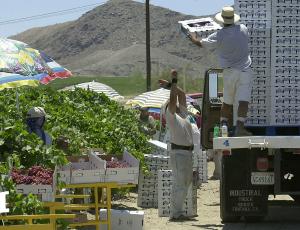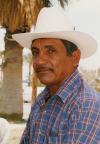|
Issue Date: September 26, 2003
Poverty-related ailments stem from housing, work, diet HEALTH AND HOUSING
By ARTHUR JONES He has 30,000 of the poorest parishioners in the United States. A working family of four averages $17,000 to $20,000 annually. “And yet,” said Fr. Bruce Cecil, “I think we have one of the most generous and lively congregations anywhere in the country.” But, said Cecil, pastor of Our Lady of Soledad Church in Coachella, “We here live in a society of have and have-not. In this area of Eastern Coachella Valley, people have been excluded systemically from all kinds of resources, be it health care, housing, livable wages or immigration documents. “Our folks do not have adequate health care. We did a parish survey: Seventy-two percent have no health insurance,” he said. “They can’t afford it. They don’t speak the language to access some of the services. The ones who have legal papers go back to Mexico for health care because it’s cheaper. Those who don’t have documents go without, unless it’s a crisis. It’s sad. It’s unfair. “It’s the first time I’ve lived in a place where, just as South Africa had racial apartheid, we have economic apartheid,” Cecil said. “There’s Duroville [a rundown trailer park] (NCR, Aug. 29) and there’s Indian Wells, with its walls and country clubs and golf courses. Millionaires’ houses within eyesight of squalor as bad as anything south of the border.”
“Bad housing is the number one environmental health risk to children in America,” contends Richard Jackson, director of the Centers for Disease Control’s National Center for Environmental Health. Ten percent of all Mexican-American 1- and 2-year-olds have elevated lead levels; in cities the situation for African-American infants is more than twice as bad, 23 percent. The National Health and Nutrition Examination Survey statistics show that at 8.5 percent, the figure for white infants is not reassuring. That’s not all. Whether exacerbated by overcrowding or the dirty conditions of old housing stock, the prevalence of pediatric asthma among poor children has reached pandemic proportions. Plus a poor diet fueled by fast foods and sugared drinks is creating an obesity epidemic. In Mecca, Calif., nurse practitioner Mary Barth, busy with mom-and-baby checks and her other patients inside the Santa Rosa del Valle mobile health clinic, has worked on the Thai-Cambodian border and in Swaziland. She notes similarities between conditions there and in some Coachella valley locations: “dirt roads, flies, lack of nutrition. There’s an anemia problem in very young children drinking too much milk and not making the transition to foods early enough or well enough. They fill up on milk and that sort of goes with the poverty.” She’s never seen malnutrition here, she said, “It’s poor nutrition, it’s part cultural -- the Latino diet is very high in carbohydrates -- and part being poor. Bread is cheaper than meat. Sugary drinks are cheap. That’s a problem with the whole country.” In addition to the full-time residents, Barth sees migrants from Mexico who come for the harvest season, and notes the contrast: “They aren’t contaminated by the American way. They’re slimmer, leaner, seem healthier.” Rudy Alegria, a physician with Clinicas de Salud del Pueblo in Mecca said there’s little balanced nutrition. It’s like housing problems, he said, a consequence “of the money situation.” Alegria, who came to the Coachella Valley originally on a National Health Service Corps scholarship, said overcrowded housing “is getting worse.” There’s statistical support for Alegria’s take. A Department of Housing and Urban Development spokesperson, using 2000 census numbers, told NCR that housing overcrowding in California’s rural areas had increased some 30 percent since the 1990 census (from 87,000 households to 113,000 households). That’s coupled -- for rural California residents -- to a 25 percent increase in the number of those living below the national poverty rate (from 361,000 to 453,000 in a decade).
Even in a poor rural state such as Mississippi, the figures are headed the other way: Overcrowding is down 5 percent; those living below the poverty rate, down 14 percent. For most national housing/health indicators, rural and urban housing have much in common: “Surprisingly,” states a 2002 study from the U.S. Office of Healthy Housing and the National Institute for Environmental Health, “large urban, small urban and rural housing had roughly the same prevalence of lead-based paint hazards.” And the high prevalence of child asthma was the other common denominator. These are the issues for the full-time Coachella Valley residents. For its 10,000-plus part-time residents, migrant farm workers following the harvests, accommodations, like health care, is a sometime thing.
The farm workers arrive in May for two months to pick table grapes and return from December through January for the celery harvest. For some, harvesting the date crop continues pretty much year round.
In a small park on Mecca’s main street near where it connects to State Highway 111, workers from Mexico like Juan from Sinaloa and Daniel from Neyarit try not to get sick. For accommodations they make do on mattresses in residents’ backyards or bunk beds in people’s garages. The luckier migrants are those who get into the Coachella Valley Housing Coalition’s new Las Mañanitas in Mecca, where for $25 a week they share a double room in one of the 11 four-person apartments, each with kitchen, bathroom, and lounge area. There are no raucus evenings here. Too tired, they’re in bed by 7 p.m. for the 4 a.m. start the next day. For retired farm workers, the coalition has built 36 units in the Desert Garden Apartments in nearby Indio, Calif. Where farm worker ailments are concerned, the main complaint is lower back pain, said clinic director Alegria. “That’s [caused by] employers who want people to hand weed. It’s worse work than the short hoes,” said Manny Benitez, California Rural Legal Assistance community worker in Coachella. Benitez, a former field worker himself, has battled on behalf of migrant and resident farm workers for years.
Relations between farm worker advocates and farmers are better than “they were maybe 15 to 50 years ago,” he said. But when “a Cal-OSHA [California Division of Safety and Health] committee tried to make rules on hand-weeding, those growers were not too friendly.” There was greater cooperation on the risks of date picking high in the palm trees. “There were some accidents, and a couple of deaths,” said Benitez, but when the state growers-advocates committee sat down to face the fact there were no safety rules for date picking, regulations were crafted. “This time the growers were OK.” Benitez said that workers injured on the job are covered by workers’ compensation. If they’re sick they go to the clinics. Places like Clinicas de Salud, which has several locations, charge on a sliding scale that includes on-premises lab tests. Santa Rosa del Valle has a $25 charge that also covers lab tests that can be done in the mobile clinic. But even once the season’s ended the need for personal endurance doesn’t end. For farm workers like Daniel, there’s the 26-hour trip home back to Nayarit in Mexico. Arthur Jones is NCR editor at large. His e-mail address is arthurjones@comcast.net.
National Catholic Reporter, September 26, 2003 |
 Migrants cope with health risks
Migrants cope with health risks

